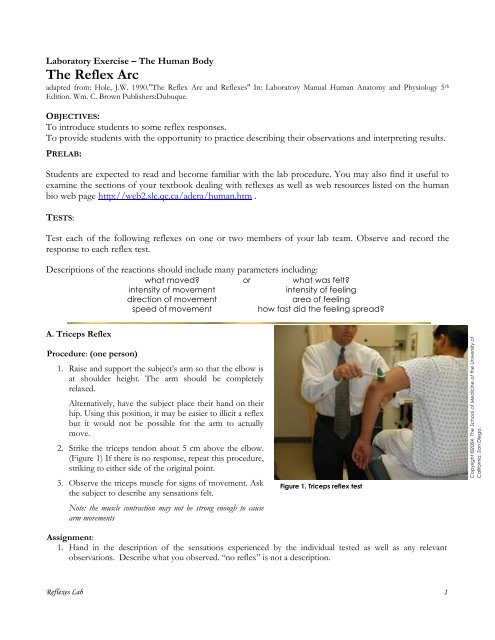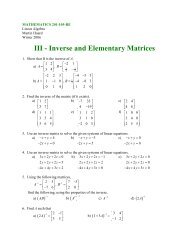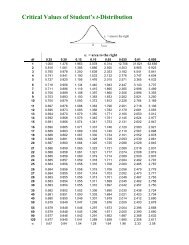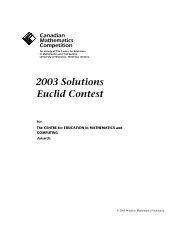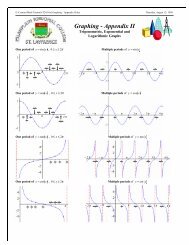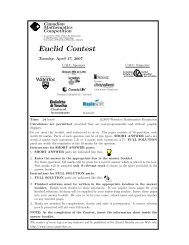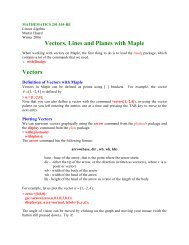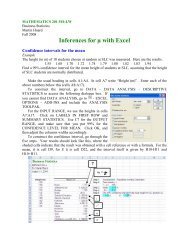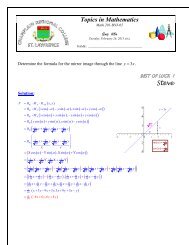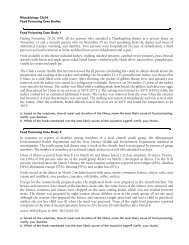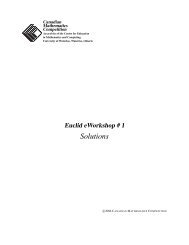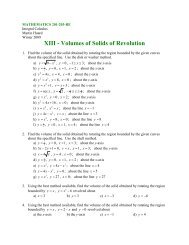"The Reflex Arc and Reflexes" In - SLC Home Page
"The Reflex Arc and Reflexes" In - SLC Home Page
"The Reflex Arc and Reflexes" In - SLC Home Page
Create successful ePaper yourself
Turn your PDF publications into a flip-book with our unique Google optimized e-Paper software.
Copyright ©2004, <strong>The</strong> School of Medicine of the University of<br />
California, San Diego.<br />
Laboratory Exercise – <strong>The</strong> Human Body<br />
<strong>The</strong> <strong>Reflex</strong> <strong>Arc</strong><br />
adapted from: Hole, J.W. 1990."<strong>The</strong> <strong>Reflex</strong> <strong>Arc</strong> <strong>and</strong> <strong>Reflex</strong>es" <strong>In</strong>: Laboratory Manual Human Anatomy <strong>and</strong> Physiology 5 th<br />
Edition. Wm. C. Brown Publishers:Dubuque.<br />
OBJECTIVES:<br />
To introduce students to some reflex responses.<br />
To provide students with the opportunity to practice describing their observations <strong>and</strong> interpreting results.<br />
PRELAB:<br />
Students are expected to read <strong>and</strong> become familiar with the lab procedure. You may also find it useful to<br />
examine the sections of your textbook dealing with reflexes as well as web resources listed on the human<br />
bio web page http://web2.slc.qc.ca/adera/human.htm .<br />
TESTS:<br />
Test each of the following reflexes on one or two members of your lab team. Observe <strong>and</strong> record the<br />
response to each reflex test.<br />
Descriptions of the reactions should include many parameters including:<br />
what moved? or what was felt?<br />
intensity of movement<br />
intensity of feeling<br />
direction of movement<br />
area of feeling<br />
speed of movement<br />
how fast did the feeling spread?<br />
A. Triceps <strong>Reflex</strong><br />
Procedure: (one person)<br />
1. Raise <strong>and</strong> support the subject’s arm so that the elbow is<br />
at shoulder height. <strong>The</strong> arm should be completely<br />
relaxed.<br />
Alternatively, have the subject place their h<strong>and</strong> on their<br />
hip. Using this position, it may be easier to illicit a reflex<br />
but it would not be possible for the arm to actually<br />
move.<br />
2. Strike the triceps tendon about 5 cm above the elbow.<br />
(Figure 1) If there is no response, repeat this procedure,<br />
striking to either side of the original point.<br />
3. Observe the triceps muscle for signs of movement. Ask<br />
the subject to describe any sensations felt.<br />
Note: the muscle contraction may not be strong enough to cause<br />
arm movements<br />
Figure 1. Triceps reflex test<br />
Assignment:<br />
1. H<strong>and</strong> in the description of the sensations experienced by the individual tested as well as any relevant<br />
observations. Describe what you observed. “no reflex” is not a description.<br />
<strong>Reflex</strong>es Lab 1
Copyright ©2004, <strong>The</strong> School of Medicine of the<br />
University of California, San Diego.<br />
Copyright ©2004, <strong>The</strong> School of Medicine of the<br />
University of California, San Diego.<br />
B. Patellar <strong>Reflex</strong> (Knee Jerk)<br />
Procedure: (two persons)<br />
1. <strong>The</strong> subject should sit comfortably with legs hanging down over<br />
the edge of a table (not touching the floor). <strong>The</strong> thigh muscles<br />
should be relaxed.<br />
2. Use the broad side of a reflex hammer to strike the patellar<br />
tendon, just below the patella (kneecap). (Figure 2)<br />
3. Observe the thigh muscle <strong>and</strong> record the action (if any) of the<br />
lower leg.<br />
Assignment:<br />
2. H<strong>and</strong> in the descriptions of the action observed for both<br />
individuals tested.<br />
3. What type of reflex is this?<br />
4. What type of receptor is stimulated in the patellar reflex?<br />
5. What is the effector for this reflex? Justify your response based on your observations.<br />
Figure 2. Patellar reflex test<br />
C. Achilles <strong>Reflex</strong> (Ankle Jerk)<br />
Procedure: (two persons)<br />
1. <strong>The</strong> subject can either lie down, with one knee bent crossing<br />
the foot over the other leg, or can be seated as for the patellar<br />
reflex test. Shoes <strong>and</strong> socks should be removed.<br />
2. Since the subject’s ankle must remain relaxed, you will need to<br />
hold their foot at a right angle before striking the Achilles<br />
tendon at the back of the ankle. (Figure 3)<br />
3. Observe the calf muscle <strong>and</strong> record the action (if any) of the<br />
foot. Where was movement observed?<br />
4. Wash your h<strong>and</strong>s with an ethanol-based sanitizer<br />
Figure 3. Achilles reflex test<br />
Assignment:<br />
6. H<strong>and</strong> in the descriptions of the action observed for both individuals tested. Describe what you observed. “no<br />
reflex” is not a description.<br />
<strong>Reflex</strong>es Lab 2
Copyright ©2004, <strong>The</strong> School of Medicine of the University of<br />
California, San Diego.<br />
D. Plantar <strong>Reflex</strong><br />
Procedure: (two persons)<br />
1. <strong>The</strong> subject should be lying down, (or seated <strong>and</strong> very relaxed) with legs in front of them <strong>and</strong> their knees<br />
slightly bent. <strong>The</strong> thigh should be rotated so that the outer side of the foot rests on a table (or chair). Shoes<br />
<strong>and</strong> socks should be removed.<br />
2. Applying firm (but not painful) pressure, draw the h<strong>and</strong>le end of the reflex hammer along the outside edge of<br />
the sole, starting at the heel <strong>and</strong> ending at the base of the big toe.<br />
3. Observe <strong>and</strong> record the movement of the toes. It may be necessary to test both feet.<br />
4. Wash your h<strong>and</strong>s with an ethanol-based sanitizer<br />
Note: It is possible that the subject will find the procedure uncomfortable (or that it tickles). <strong>The</strong> test will not work on such individuals.<br />
Assignment:<br />
7. H<strong>and</strong> in the descriptions of the action observed for both individuals tested.<br />
8. <strong>The</strong> reaction of this reflex is that the toes either move upwards or downwards. Which response is considered<br />
normal? (use your textbook as a guide) What would an abnormal response indicate?<br />
E. Biceps <strong>Reflex</strong><br />
Procedure: (one person)<br />
1. <strong>The</strong> subject should be seated at a table or a desk. <strong>The</strong><br />
elbow should be bent <strong>and</strong> the arm completely relaxed,<br />
resting either on your arm or the subject’s own lap.<br />
2. Gently press the biceps tendon in the antecubital fossa<br />
with your thumb (or forefinger), <strong>and</strong> strike your thumb<br />
with the reflex hammer. (Figure 4) Note: you should be<br />
able to feel the thick tendon with your thumb.<br />
3. Observe the biceps muscle for signs of movement. Ask<br />
the subject to describe any sensations felt.<br />
Note: the muscle contraction may not be strong enough to cause<br />
arm movements<br />
Figure 4. Biceps reflex test<br />
Assignment:<br />
9. H<strong>and</strong> in the description of the sensations experienced by the individual tested as well as any relevant<br />
observations.<br />
F. Pupillary Light <strong>Reflex</strong><br />
Procedure: (one person)<br />
1. Have one laboratory partner cover one eye. Briefly shine a light into the uncovered eye <strong>and</strong> observe the pupil.<br />
Assignment:<br />
10. Describe the change in the pupil before, during <strong>and</strong> after exposure to light.<br />
11. Identify each of the specific components of a reflex arc within the pupillary light reflex<br />
<strong>Reflex</strong>es Lab 3
Images from: http://medicine.ucsd.edu/clinicalmed/neuro3.htm<br />
ASSIGNMENT (due February 18, 2009)<br />
You are required to h<strong>and</strong> in one lab report per team. All lab reports must be typed.<br />
Write in the past tense when describing your own work.<br />
You are expected to work in collaboration with the other member(s) of your lab team.<br />
Avoid quotes <strong>and</strong>, of course, copying. Answer in your own words <strong>and</strong> cite ideas from references when appropriate.<br />
1. H<strong>and</strong> in the descriptions of all your observations of the reflex responses. Parameters you should consider when<br />
observing the subjects' reactions include: what moved (or what was felt), intensity, direction, <strong>and</strong> speed.<br />
2. Provide the answers to questions posed in each of the Assignment sections.<br />
3. Choose one of the reflex tests where two subjects were examined (knee jerk, ankle jerk, or plantar reflex) <strong>and</strong><br />
compare the responses of the two subjects. Your comparison should include features they have in common as<br />
well as ways that they differ. Provide one possible reason for why the two subjects had different responses <strong>and</strong><br />
provide support for your idea by citing a reliable reference.<br />
To improve your descriptions, try reading a description to someone not in the class <strong>and</strong> ask that person to “act out”<br />
what you have described. If they are unable to repeat the movements you have described, or if their movement is<br />
not what you expected, your description may be inaccurate or incomplete <strong>and</strong> needs to be clarified.<br />
Sample Marking Grid<br />
description of reactions<br />
(0.5) what moved or what was felt<br />
(0.5) intensity<br />
(0.5) direction of movement or area where sensation was felt<br />
(0.5) speed<br />
/2 Triceps reflex (muscle twitch)<br />
description<br />
/8 Patellar reflex (leg kicks)<br />
/2 description person 1<br />
/2 description person 2<br />
/1 type of reflex<br />
/1 name of receptor<br />
/2 effector<br />
named<br />
justified based on observations<br />
/4 Achilles reflex (ankle jerk)<br />
/2 description person 1<br />
/2 description person 2<br />
/6 Plantar reflex (toes move)<br />
/2 description person 1<br />
/2 description person 2<br />
/1 normal response – defined<br />
/1 abnormal response indicates ?<br />
/2 Biceps reflex (muscle twitch)<br />
description<br />
/7 Pupillary Light <strong>Reflex</strong><br />
/2 description<br />
/5 identify the reflex arc components<br />
/7 Comparison of responses of two subjects<br />
/2 common features<br />
/2 differences<br />
/3 possible reason for differences<br />
how was choice determined? (1)<br />
justification of choice<br />
data (1)<br />
reference (1)<br />
/4 Formatting, Grammar <strong>and</strong> Style<br />
/40 Total<br />
<strong>Reflex</strong>es Lab 4


